Fujairah, Something of a Surprise
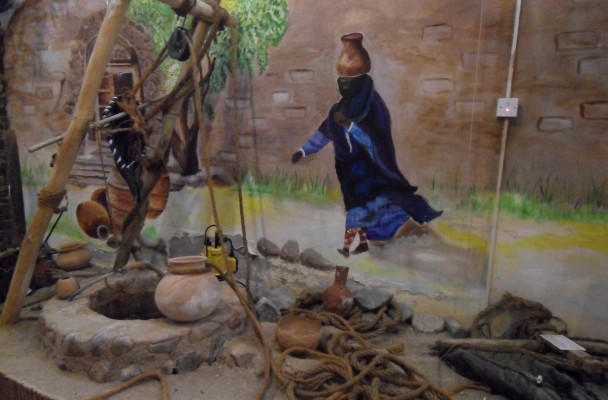
Display in the Fujairah Museum depicts a traditional women at a well to drawn water
From the sea, Fujairah appears to be a narrow strip of flat land with tall, starkly barren mountains rising immediately behind the coast. But hidden in the valleys or wadis of those rugged mountains are beautiful oases barely visible from the road except for the tops of the graceful palm trees that characterize the landscape. There, the land is watered by rivers flowing through the wadis that enabling extensive agriculture to flourish. Today, a modern touch can be seen with the addition of greenhouses where a great variety of vegetables and fruits are grown.
Rainfall is higher in Fujairah than the rest of the UAE, in part because of the mountains but also because the prevailing winds from the east bring moisture-filled clouds off the warm Indian Ocean.
Fujairah, one of the seven members of the United Arab Emirates, is the only one situated on the Gulf of Oman (the others stretch along the Persian or Arabian Gulf, west of the Straits of Hormuz). Indeed, Fujairah’s strategic location was the reason it was chosen as the terminal for the Habshan–Fujairah oil pipeline. Opened in July 2012, it was built specifically as an alternative to bring oil from Abu Dhabi to avoid having to pass through the Straits of Hormuz. (More than 30 percent of the world’s crude oil exports pass through the Strait of Hormuz.)
The new pipeline, extending 220 miles (350 kms) from the oil fields in Abu Dhabi to the Port of Fujairah and costing over $3 billion, has enabled the UAE’s oil industry, for the first time, to export 1.5 million barrels per day — more than 50 percent of its oil production — this way. The pipeline’s role has been all the more important each time Iran has threatened to close the Strait. Today, Fujairah is a major bunkering port with large scale shipping operations and related services.
Fujairah was part of Sharjah and thus a British Protectorate until 1952, when it gained its independence. It joined the UAE when the latter was formed in 1971. Less developed than Dubai or Sharjah, nonetheless it is moving surely from a once isolated community of fisherman, pearl divers, and nomadic tribes into a new society with the trappings of modern four-lane highways, shopping malls, and beaches lined with new hotels attracting European, Russian, and other tourists eager to soak up the sun along these shores. Its large Free Zone is home to over 500 companies and employees as many as 10,000 people.
Fujairah’s population has grown from 120,000 in 2005, when the last census was taken, to about 400,000, of which 60% are foreign nationals. The ruler of Fujairah, His Highness Sheikh Hamad bin Mohammed Al Sharqi, has been in power since his father’s death in 1974. The ruler can make any decision regarding any aspect of law, although federal laws are supposed to take precedence. However, you are likely to view that with skepticism when you learn that the Sheikh and his immediate family head the Fujairah cabinet, and he must ratify all decisions of the cabinet. A few members of respected local families make up the advisory committees.
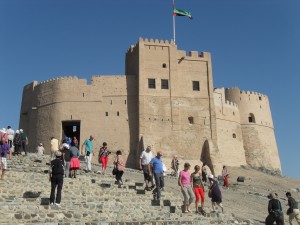 Fujairah has a number of interesting attractions which are visited on most tours. In close proximity are the Fujairah Fort, Fujairah Museum and Fujairah Heritage Village, all located five miles from the port:
Fujairah has a number of interesting attractions which are visited on most tours. In close proximity are the Fujairah Fort, Fujairah Museum and Fujairah Heritage Village, all located five miles from the port:
Fujairah Fort With a commanding position on a hill at the edge of town, the fort dates from the 16th century and was the first building in stone along the Fujairah coast. It was once the home of the ruling family as well as a defensive structure. The building was reconstructed twice in its history and has undergone two more recent restorations, the last in 2000 by the Department of Antiquities and Heritage. Its unusual feature is the combination of two round towers and one square one, the latter being dictated by the lay of the land.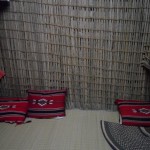
Fujairah Heritage Village: Created to give visitors a glimpse of how the local people once lived, there are traditional homes made of reed from palm leaves, tools used in everyday life, the irrigation system, and fishing boats made of palms. My favorite is a display of spices with descriptions for each of its uses.
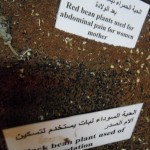 Fujairah Museum: The collections are housed in three halls: The first displays the occupations of the region, such as agriculture, fishing, weaving and pottery making. The second includes ancient weapons, popular costumes and utensils and a model of an old house made of palm leaves. The third and most interesting hall of antiquities has the artifacts found during archaeological excavations at Qidfa and Bithmah and include Bronze and Iron Age weapons, painted pottery, vessels carved from soapstone, and pre-Islamic silver coins.
Fujairah Museum: The collections are housed in three halls: The first displays the occupations of the region, such as agriculture, fishing, weaving and pottery making. The second includes ancient weapons, popular costumes and utensils and a model of an old house made of palm leaves. The third and most interesting hall of antiquities has the artifacts found during archaeological excavations at Qidfa and Bithmah and include Bronze and Iron Age weapons, painted pottery, vessels carved from soapstone, and pre-Islamic silver coins.
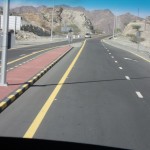 Outside of town, a four-lane highway winds through the Hajjar mountains, passing villages all but hidden under the green of the oases in the wadis, to the town of Masafi, known for its Friday market, and which Fujairah shares with its neighboring emirate of Ras el-Khaimah.
Outside of town, a four-lane highway winds through the Hajjar mountains, passing villages all but hidden under the green of the oases in the wadis, to the town of Masafi, known for its Friday market, and which Fujairah shares with its neighboring emirate of Ras el-Khaimah.
Hajjar Mountains are the highest mountain range in eastern Arabia and run through both the UAE and Oman. The highest point, Jabal Yibir, at 5,039 feet (1,527 meters) is in the UAE. This wild and beautiful mountain range west of Fujairah is popular locally for hiking and picnicking by its seasonal rivers and springs.
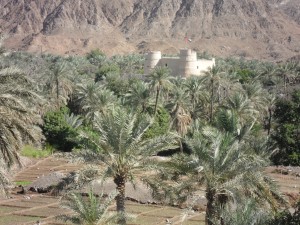 Bithnah Fort In the distance protruding out the top of date palms in the Ham Valley is another of Fujairah’s forts, Al Bithnah, about 9 miles from town. The large, quadrangular building has two towers facing west and used to monitor the land in that directions. Estimated to date from about 1735, it was well-constructed using stones bound with mortar and coated with plaster. The southwest tower collapsed at one stage and was rebuilt using modern materials. There are also remains of dwellings associated with the fort and archaeologists have uncovered several ancient burial chambers.
Bithnah Fort In the distance protruding out the top of date palms in the Ham Valley is another of Fujairah’s forts, Al Bithnah, about 9 miles from town. The large, quadrangular building has two towers facing west and used to monitor the land in that directions. Estimated to date from about 1735, it was well-constructed using stones bound with mortar and coated with plaster. The southwest tower collapsed at one stage and was rebuilt using modern materials. There are also remains of dwellings associated with the fort and archaeologists have uncovered several ancient burial chambers.
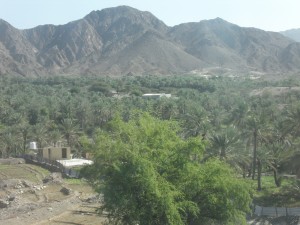 Wadi Ham The largest and longest wadi in the UAE, Wadi Ham runs for 18 miles (30kms) from Masafi to the dam, some of which is accessible from the main road. The wadi remains dry for most of the year but when it does rain, the dry riverbed is transformed into rushng waters.
Wadi Ham The largest and longest wadi in the UAE, Wadi Ham runs for 18 miles (30kms) from Masafi to the dam, some of which is accessible from the main road. The wadi remains dry for most of the year but when it does rain, the dry riverbed is transformed into rushng waters.
Water Sports: Fujairah, being the only Emirate that borders the Indian Ocean, offers unusual marine life and swimming, diving, snorkeling, fishing, kayaking, and more which most hotels can arrange for you. The Fujairah International Marine Club offers many of these sports, too. For information: www.adventuresports.ae
Hiking: Fujairah hiking can take you into the scenic Hajjar Mountains for an unusual experience. Several trails are available. One of the most popular hikes is at Ain Al Ghamour, set among springs, waterfalls and valleys. Inquire from the Fujairah Tourism & Antiquities Authority, tel: 00971-9-223-1554; www.fujairahtourism.ae; info@fujairahtourism.ae
Mountain Climbing With its rugged mountains, Fujairah is a natural for adventurers eager to climb the highest peaks. The Hajjar Mountains’ terrain provide vast range of challenges. Climbers are advised to be well prepared as the climbs can be treacherous.
Cycling With winding wadis and steep mountain ridges, cycling in Fujairah is a real treat through the beautiful landscape for those up to the challenge. For information: www.biking-emirates.com
Powerboat Racing: Fujairah has hosted several powerboat — F1, F2 and X-CAT –championship races. The waters of the Indian Ocean offer racers a tough challenge and spectators an unusual experience.
By Kay Showker on Oceania Cruises’ Nautica, somewhere in the Indian Ocean

Leave a Reply